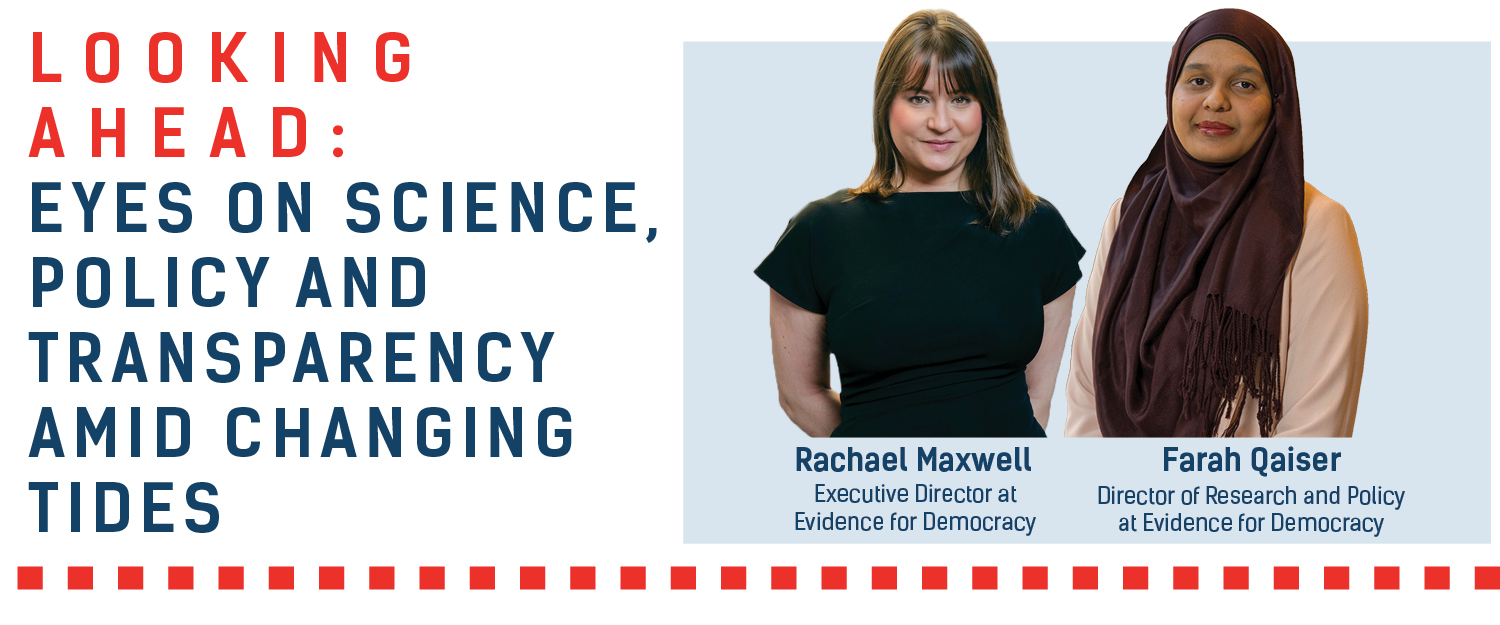Looking Ahead: Eyes on Science, Policy and Transparency Amid Changing Tides

Author(s):
Rachael Maxwell
Evidence for Democracy
Executive Director
Farah Qaiser
Evidence for Democracy
Director of Research and Policy
What a year it’s been since the last Canadian Science Policy Conference.
Since then, we’ve continued to navigate a global pandemic, received the first federal budget in two years, and most recently, braved a fast-paced 36-day long federal election.
And at Evidence for Democracy, we’ve been through some changes too. We bid farewell to the former leadership team, and welcomed an entirely new cast of faces, with a new Executive Director at the helm.
So, what new waters are we about to brave together?
To put these times into perspective, we’re closing in on the ten year anniversary of the ‘Death of Evidence’ rallies next year. It was a dramatic turning point for the science community in Canada and, as chance would have it, spurred the birth of Evidence for Democracy. There have been some good signals from the federal government in this past decade, such as the introduction of a Minister of Science, the appointment of a Chief Science Advisor, and the 2017 Fundamental Science Review.
But each of these signals has a caveat. The Minister of Science role no longer exists, leaving the science portfolio under the mandate of the Minister of Innovation, Science and Industry. The Office of the Chief Science Advisor continues to not be protected to withstand changes in government, and several recommendations from the Fundamental Science Review are unresolved. And on top of all this, transparency remains a persistently missing link when it comes to the role of evidence and how governments make decisions. How can we assess progress on evidence-informed decision-making, without understanding what information goes into complex policy decisions?
To add to this, there are indications of growing distrust across key societal institutions, such as healthcare and government. Very quickly, the bigger picture starts to feel very messy. There are several root causes to consider here, including levels of political cohesiveness, social trust, income equality, mis/disinformation, and collectivism — and importantly, science isn’t immune to any of these factors.
To continue to build trust in science and move forward, it will take coordinated action across the Canadian federation. From elected representatives to scientists, to academic institutions and every level of government, all stakeholders need to step up and play their part.
As a starting point, we can turn to the recent federal election, and what this new, yet familiar, government composition might mean for science and evidence in Canada.
Given the limited shelf life of minority governments, it’s hard to imagine a scenario where deep advances are made on critical science issues, such as improving Canada’s investments in fundamental science or developing a national science strategy. One of the proposals from the Liberal Party’s election platform was a plan to mobilize a Canadian version of one of the global north’s biggest research success stories, the Defense Advanced Research Projects Agency. Again, given the size and scope of such an endeavour, it feels aggressively optimistic to imagine the Canadian riff (cutely named CARPA) will grow legs to stand on in the next 18-24 months.
One area where science and evidence might be able to make some in-roads is the new Standing Committee on Science and Research, a motion which received unanimous approval in the last session of Parliament. While the mandate of the new committee remains up in the air, this will be a key opportunity for all parties to weigh in and work together, all under the keen eyes of a science community that continues to demonstrate a growing desire to make policy-relevant contributions.
At Evidence for Democracy, we’re continuing to keep our eyes on evidence. In 2021, we adapted a framework from Sense About Science in the United Kingdom to evaluate the transparency of evidence underlying policy decisions. Simply put: can the evidence behind policies be found by the lay public? Now, we’re applying this framework to evaluate policies from science-based federal departments and agencies, including bills, regulations, and funding announcements. We’ll be releasing our findings shortly, and potentially, bringing this important work to the provincial level next.
And of course, we’re also keeping our eyes on what happens next for the Office of the Chief Science Advisor. While the office was renewed for a second two-year term in September 2020, it is still not protected by any official measure to withstand changes in government. Given the extraordinary strain on the relationship between science and government over the course of the pandemic, this should be of concern for advancing an evidence agenda.
But all of this will only be possible if there is sustained and deliberate engagement from the Canadian science community. This means staying engaged, and in some cases, taking a dive into unknown waters. From running for office, to developing skills in empathetic science communication, or appearing before Parliamentary Committees, every action matters when it comes to getting evidence into the hands of those who need it most.
While we hope it goes without saying, Evidence for Democracy is here to help you mobilize science to policy, through targeted research, training, campaigns and the many opportunities that surely lay in wait. Because, we all benefit when governments make decisions informed by the best available evidence.

